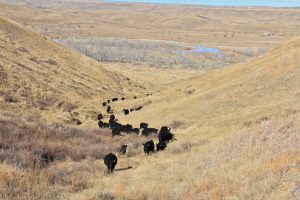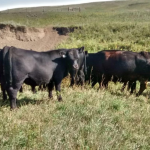LRP now available on forward contracted cattle, other changes impact dairy, cull cows and more
The U.S. Department of Agriculture’s (USDA’s) Risk Management Agency (RMA) implemented several changes to the Livestock Risk Protection (LRP) on July 1, 2025.
LRP changes that will affect beef cattle producers include:
Billing date for endorsements booked on July 1, 2025 or later:
- You will be billed 2 months after the endorsement expires instead of 1 month.
- Example: The endorsement expires in November 2025. The first bill will go out in early January 2026.
Addressing “subsidy capture”: This is the new rule affecting those who buy puts/options:
- Subsidy capture is an attempt to recover the LRP premium cost by using futures or options as an offsetting position to the LRP in close proximity to the date the endorsement was booked.
- RMA can now ask for your trading account transaction statements.
- If RMA determines you traded for the purpose of subsidy capture or you refuse to provide trading account records, claims will be denied and premium will still be owed.
- You will need to sign a certification statement that you did not trade for the purpose of subsidy capture.
Insuring cattle based on purchase agreements:
- Ownership interest can be based on a valid livestock purchase agreement, even if the livestock is not yet in your physical possession.
- Must take possession of covered livestock no later than 90 days prior to the SCE end date.
- For example:
- You complete a purchase agreement to buy cattle on August 30. You then book an LRP endorsement on Sept. 1 that expires on Jan. 15.
- You must take possession of the cattle by Oct. 15
For fed cattle and sold feeder cattle, to receive an indemnity you must provide:
- Documents verifying the sale of all covered livestock sold no later than 60 days after the end date
- If the feeder cattle are unsold more than 60 days after the end date, you must sign a certification statement
Drought exemption for feeder cattle only:
- Based on the Drought Coverage and Severity Index in the county where the cattle are located
- If you qualify for a drought hardship exemption, you can still be eligible for a claim if you sold the livestock more than 60 days before the endorsement end date.
Adding two new types of LRP coverage:
- Feeder Cattle – Unborn Calves will provide coverage for beef or beef/dairy cross calves sold within two weeks after birth.
- Fed Cattle – Cull Cows will provide coverage for dairy cull cows with a coverage limitation of 13 weeks.
Additional changes affect the Dairy Revenue Protection program and/or the Livestock Gross Margin program.
“These changes underscore RMA’s commitment to ensuring producers have the tools they need to manage risk effectively,” said James Bellmon, Director of the RMA Regional Office in Oklahoma City, in a May, 2025, USDA news release. “The inclusion of coverage for forward contracts, along with coverage for unborn calves and cull cows, were requested by stakeholders. Additionally, modifying the termination dates allows more time for Approved Insurance Providers to properly process claims and premiums.”
Jack Payne, owner of Nevada Livestock Marketing in Fallon, Nevada, is concerned that LRP may not benefit all sectors of the industry, and he acknowledges that many in in the industry are focused on the insurance product.
“Point number 2 out of Common Ground Summit is described as ‘improving LRP.'”
Payne asks, “improving LRP for who? Salebarn owners and industry leaders need to take a close look at these changes and weigh the potential side effects,” he said. “It is my understanding that this change opens up the door for two entities, the buyer and the seller, to own an LRP policy on the same group of cattle.”
“If that’s true, it’s good for the insurance companies,” he said.
“If the buyers are under contract but only $40 or $100 per head down payment is required by the video companies how easy is it for buyers to walk away? Sometimes it’s out of the buyer’s control, if the market crashes banks are going to react. We’ve seen it happen in the past when cattle were half the value they are now.”
Payne is pleased that sellers are able to maintain coverage until delivery date. “I don’t think it’s a good idea to leave sellers exposed in order to give the buyers coverage on cattle they have not taken delivery of.”
Another one of Payne’s concerns is the effects on salebarns if video buyers can get coverage months before delivery date. “What incentive will buyers have to support their local auction markets if they can fill all their cattle needs months in advance with no market risk? Ninety percent of the cattle in the US are owned by producers with less than 100 head. These producers are unable to sell on the video markets because they don’t have the required load lots.
“If the goal is to keep producers on the land and increase producer profitability, it’s important to consider the side effects and market consequences on 90 percent of the industry just to benefit the 10 percent who are large operators. We are already on the fast track to vertical integration and helping the big get bigger while putting small producers at a disadvantage should not be labeled as ‘improving LRP,'” he said.
Payne’s last concern is how LRP changes will affect the futures market. Before LRP changes insurance policies on cattle were taken out shortly after the delivery date which typically is scattered out over several months. With new rule changes we could see potentially up to 500,000 head of cattle insured in one day. In this high market insurance companies are not going to leave themselves exposed for $100s of millions in risk. Those insurance companies will be shorting the board for their own protection. This will obviously trigger algorithms and could cause limit down days on the CME. The industry needs to have open discussions about this and set parameters around how many contracts can be signed up in one day or even one week. It’s important that real conversations are had with real producers about these changes and their potential side effects so that we don’t shoot our own foot off by helping give video companies further advantage over the salebarns who market most of America’s cattle said Payne.
According to Lavy Steiner, Belfield, North Dakota, an LRP representative, the rules regarding forward contracts were not clear and were difficult to enforce, and the new rule clears up some confusion. Under the new rule, a seller can maintain an LRP contract on cattle sold on the video or internet, and the buyer can purchase an LRP contract on those same cattle at the time of the sale.
Brett Kenzy, past president of R-CALF USA and co-owner of Kenzy Backgrounding near Gregory, South Dakota, said, all other points aside, a fair, transparent marketing system is necessary for the entire industry to function properly
“There are a lot of ways to sell cattle, but it’s hard to argue with the fact that the sale barns reflect the value on that day for those cattle in that geographical location. We need salebarns for that competitive transparent market, and we need to be careful policy doesn’t encourage the industry to make marketing decisions for the wrong reasons,” he said. “Ultimately, competitive value discovery is crucial. When the gavel clacks, value is determined for each animal, and ownership transfers that day.”
“If you have a tool that isn’t working because you don’t have a competitive, transparent market for a class of cattle, then look at the big picture,” he said.
“LRP will only be as good as the CME. The CME will only ever be as good as the competitive transparent markets that are supposed to inform and guide the entity established to be a hedging tool.
“The integrity of the cash market is the foundation of our industry, all the rest is the tail wagging the dog, no matter how heavily subsidized by the American taxpayer it is,” Kenzy said.
Western Video Market owners Jake Parnell and Justin Nieson said they believe the “brick and mortar” auction barn and the video sale option are both important options for cattle producers.
Parnell is an owner in Cattlemen’s Livestock Market, Galt, California, which facilitates the sale of about 90,000 head of cattle each year, and he represents about 8,000 to 9,000 head of cattle on WVM each year.
WVM vets potential buyers in an effort to be sure they have the ability to follow through with cattle purchases, said Parnell. Buyers are required to put $100 per head down immediately after the purchase is made. He said on the rare occasion a buyer isn’t able to complete the purchase upon delivery, WVM “have stood behind the cattle and made the producers whole,” he said.
“This is an honest industry built on integrity and a handshake,” he said, adding that most transactions go off without a hitch.
Parnell agrees that the traditional auction barn is an important piece of the puzzle. “I just think this industry works in unison and there is a spot for it all. The sale barn is important to the livelihood of the industry and the livelihood of rural America. It’s a hub that gets peope off the ranch and into town to do business,” he said.
Parnell agrees with Payne that the vast majority of cattle in the U.S. are not eligible for video sales because of small herd size.
But he believes that a strengthened LRP program is a tool that might help convince young producers to return to the farm or ranch because it helps them manage risk.
St. Onge Livestock manager and Superior Livestock Auction representative Justin Tupper believes the LRP changes are purely positive. He said Superior enforces all of their purchase agreements, so buyers can’t “back out.”
Tupper, the president of the U.S. Cattlemen’s Association, said that giving the buyer and seller both the ability to cover the value of the calves is a producer-friendly concept.
“If that buyer loses money and goes out of business, why would you want that? Wouldn’t you want them to be able to protect those cattle?”
“Those small family feedlots have gone out of business at the highest rate of anyone. They haven’t been able to be profitable. If they can lock in a profit, I think that’s a plus, it helps encourage them to buy cattle, lock them in, and buy cattle at the video or at the barn,” he said.
“This is just another tool in the toolbox they can use to protect themselves, especially with the market so high,” he said.
Tupper markets around 15,000 head of calves and yearlings on Superior Livestock each year, and around 120,000 head of total cattle through St. Onge Livestock annually.
The Common Ground Summit a recent Livestock Marketing Association-led gathering of industry representatives agreed to five industry issues. One of their key issues was “more effective” risk management.
Days later the USDA announced changes including this one. The Common Ground Summit website outlines the group’s support for this very issue.
Tupper would like to see LRP subsidized at a higher percentage, and he believes this would be a bigger win for the industry than the recent changes.
Carie Kobiela, a Nebraska-based LRP sales agent says it is important to remember that over the last 3–5 years, there have been several positive changes made to LRP policies that have made them more attractive and accessible for producers. These changes were largely in response to industry feedback and designed to improve flexibility, affordability, and participation for any producer, large or small.
A few Changes to LRP (2019–2024)
1. Increased Premium Subsidies (Effective July 1, 2020) Subsidy rates increased, depending on the coverage level
2. USDA Risk Management Agency (RMA) made key changes in 2022 to increase the number of livestock that can be covered under LRP.
Fed Cattle & Feeder Cattle:
Per Endorsement:Increased from 1,000 head to 6,000 head
Per Crop Year:Increased from 2,000 head to 25,000 head
3. Premium Payments not being required upfront, allow the producer additional time to make premium
4. Specific Rules put in place to define the boundaries of the policies’ coverages
5. Changes made in reference to the policies put in place to protect cattle sold and delivered later (video marketed), have allowed both the buyer and the seller the opportunity to put a floor on their cattle without the risk of margin calls.
“The most important point to all of this, that is highly overlooked, LRP insurance, is to protect against dramatic decline in the market. Without coverage some producers may be out of business if the bottom falls out,” she said.



